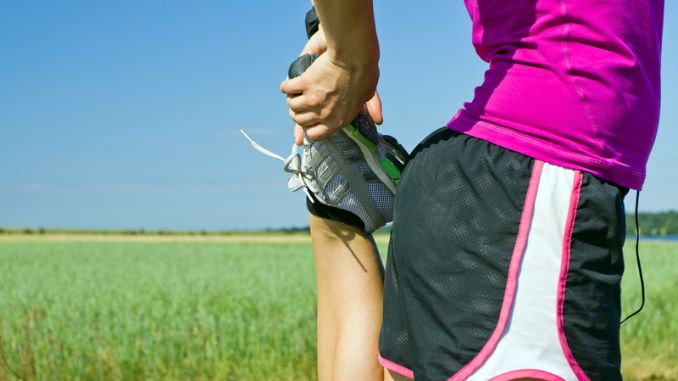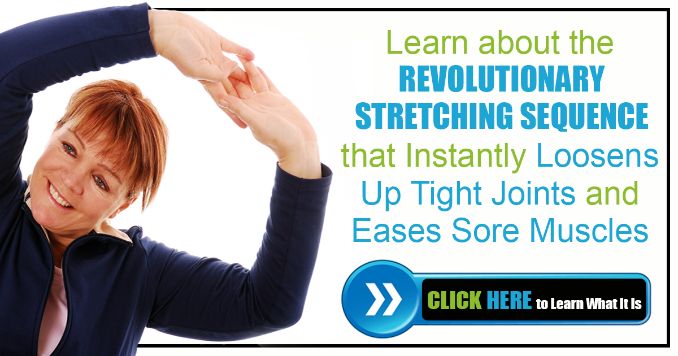Stretching after walking stretches helps your body feel good, stay flexible, and reduce the risk of injury.
Furthermore, when you stretch, you relax tight muscles and keep your joints moving well.
This routine includes seven simple stretches that you can do immediately after walking to help your legs, hips, and then calves recover.
They’re easy to follow, take only a few minutes, and can make your next walk feel even better.
Physical therapist Dave Candy, DPT, says to stretch your calves and hip flexors after walking. Tight calves can affect your step and foot position, while tight hip flexors can limit your leg movement and cause lower back strain.
1. Standing Calf Stretch (Gastrocnemius)
For this exercise, utilize the wall for support if needed.
- Begin in an upright standing position facing the wall, with your feet hip-width apart.
- Maintain good alignment with your head, shoulder, hips, and then legs.
- After that, place both your hands on the wall.
- Engage your core and take a step back with your one foot.
- Bend the front knee and then lean towards the wall, feeling the stretch in the back leg.
- Hold this position for several deep belly breaths, in through your nose and then out through your mouth.
- Repeat the movement.
Why: Walking loads the calf muscles; prolonged walking can increase tendon compliance, so a gentle stretch helps restore balance between tendon and muscle length.
2. Standing Hamstring Stretch
- Begin in an upright standing position with one hand against the wall or hold on to a walking stick for balance.
- Hinge through your hips as you straighten one leg out front, pointing your toes toward the ceiling.
- In addition, hold this position for 20 seconds.
- Return to the starting position and repeat the movement on the opposite leg.
- Start off with one set of 2 repetitions on each side, holding for 20 seconds.
- The intensity is light.
- The purpose of this walking stretches exercise is to target the hamstrings.
3. Standing Calf Stretch
- Begin the great post-walk stretch routine in an upright standing position with your hands against the wall or hold on to a walking stick for balance.
- Take a big step back with one foot, keeping your toes pointing straight ahead and your heels flat on the floor.
- Bend your front knee and straighten your back leg.
- Maintain good alignment with your head, shoulders, and hips.
- Hold this position for 20 seconds.
- Return to the starting position and repeat the movement on the opposite leg for stretches after walking.
4. Cross-over Leg Stretch
- Begin the great post-walk stretch routine, in an upright sitting position.
- Cross one leg over placing the heel on the opposite knee.
- Looking for a stretch in the hip and joint area, push the bended knee toward the floor for added pressure.
- After that, hold this position for 20 seconds.
- Return to the starting position and then repeat the movement on the opposite leg.
- Start off with one set of 2 repetitions on each side, holding the position for 20 seconds.
- The intensity of this exercise is light.
- The purpose of this exercise is to target the muscles around the hips, specifically the rotators of the hips.
5. Soleus Stretch (Bent-Knee Calf Stretch)
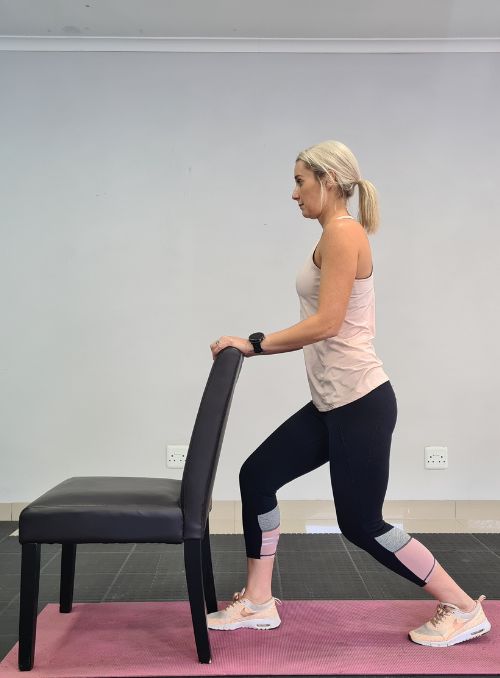
For this exercise, utilize a chair, wall, or any stable surface for support.
- Begin in an upright standing position facing the back of a chair, with your feet hip-width apart.
- Place both hands on the chair for balance.
- Step one foot back, keeping the toes pointing forward and the heel firmly on the ground.
- Bend both knees slightly while maintaining good alignment with your head, shoulders, and hips.
- Shift your weight forward onto your front leg until you feel a light stretch in the lower calf (soleus) of the back leg.
- Hold this position for several deep belly breaths, in through your nose and out through your mouth.
- Relax and return to the starting position.
- Repeat the movement on the opposite side.
Why: Specifically targets the soleus, which showed significant compliance changes in prolonged walking studies.
6. Standing Quadriceps Stretch
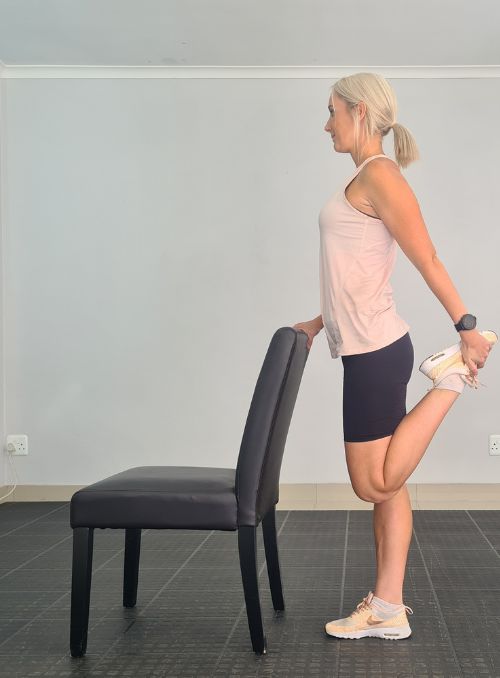
- Begin in an upright standing position, maintaining good alignment with your head, shoulders, and hips.
- Stand on one leg and grab your other ankle with your hand.
- Pull your ankle gently towards your buttocks.
- Hold this position for 20-30 seconds, maintaining balance and keeping your core engaged.
- Return to the starting position and switch legs to repeat the movement on the opposite side.
Why: Maintains hip and knee mobility, which supports stride length and reduces joint stress.
7. Hamstring Stretch
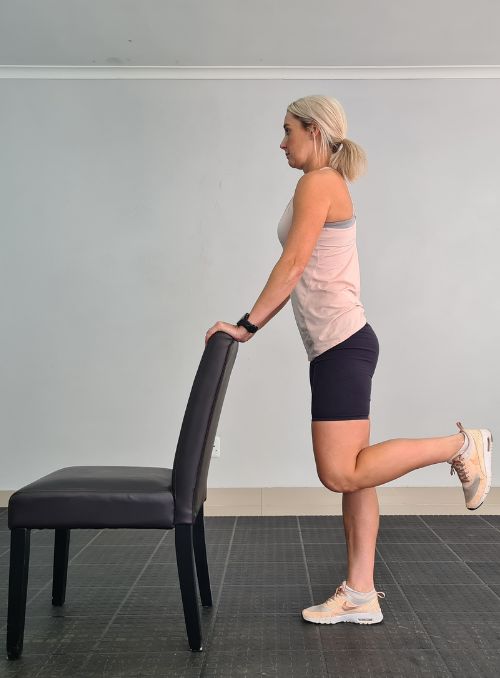
For this exercise, utilize a chair or any stable surface for support.
- Begin in an upright standing position facing the back of a chair, with your feet hip-width apart.
- After that, place both hands on the chair for balance.
- Place one heel on the chair with your leg straight and then toes pointing up.
- Keep your back straight, hinge forward slightly at the hips, and feel the stretch along the back of your thigh (hamstrings).
- Maintain good posture with your head, shoulders, and then hips aligned.
- Hold the position for several deep belly breaths, in through your nose and out through your mouth.
- Relax and then return to the starting position.
- Repeat the movement on the opposite side.
Why: Walking works hamstrings in a lengthened position; stretching preserves flexibility and may help posture.
8. Hip Flexor Stretch
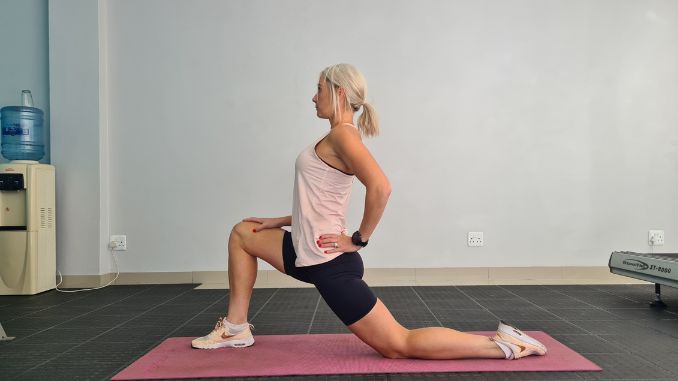
- Begin in a lunge position on the floor with one knee bent in front at a 90-degree angle and the other leg extended back, resting your knee and then the top of your foot on the floor.
- Place your hands on your hips or your front thigh for support.
- Maintain good alignment with your head, shoulders, and then hips.
- After that, gently shift your hips forward while keeping your torso upright to feel a stretch in the front of the hip and thigh of the back leg.
- Hold this position for several deep belly breaths, in through your nose and out through your mouth.
- Relax and then return to the starting position.
- Repeat the movement on the opposite side.
Why: Walking uses hip flexors repeatedly; stretching reduces tightness that can alter gait mechanics.
9. Cross-over Leg Stretch
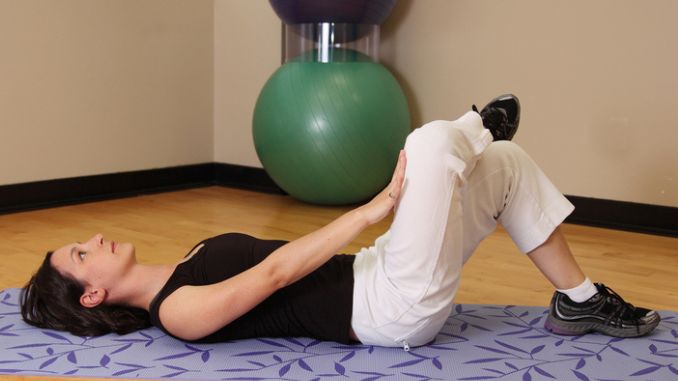
- Begin by lying on your back on the floor with your knees bent and then feet flat on the mat.
- Maintain good alignment in your head, shoulders, and hips during post walk stretches.
- After that, engage your core.
- Lift one leg and cross the ankle over the opposite knee, creating a figure-four shape.
- Hold the back of the thigh of your supporting leg with both hands and gently pull it toward your chest until you feel a stretch in your glutes and outer hip.
- Hold this position for several deep belly breaths, in through your nose and out through your mouth.
- Slowly return to the starting position and then repeat the movement on the opposite side.
10. Cat-Cow
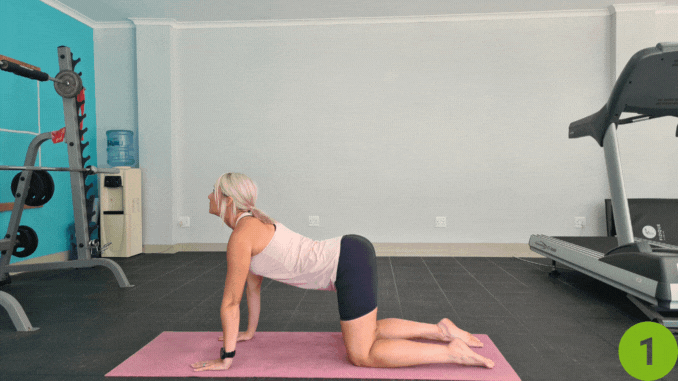
- Begin in a 4-point position with your hands beneath your shoulders and then your knees under your hips.
- Inhale and then contract your abdominal area stretches after walking.
- Exhale and then slowly round out your mid-back as you drop your head downward.
- After that, then alternate by inhaling as you slowly lift your head and arch your mid-back.
- Perform 8–10 slow, controlled repetitions.
Why: Helps relax spinal muscles after upright repetitive motion.
Why Walking Is Good for You
Walking is safe [1] and then easy for almost everyone.
It helps lower the chances of getting:
- Diabetes (high blood sugar problems)
- Obesity (too much body fat)
- High blood pressure
- Heart Diseases
You can do it anywhere, with no special equipment.
Benefits of Regular Stretching
- Regular stretching [2] can improve flexibility and range of motion.
- It can reduce muscle soreness and improve recovery time after physical activities.
- Post walk stretches can also help alleviate stress and improve overall well-being.
- Incorporate stretches after walking into your daily routine to experience the benefits for yourself.
- Make stretching a habit to maintain flexibility and prevent injuries.
Why Post-Walk Stretching Is Important
Increased tendon compliance [3] after long walking means your tendons are temporarily more pliable.
Stretching immediately after walking may:
- Target the muscle fibers more effectively because tendons already have increased flexibility from stretches after walking.
- Help restore normal muscle–tendon interaction by gently encouraging optimal length in both muscle and tendon tissues.
However, since sensory feedback is temporarily reduced, stretching should be controlled and mindful to avoid overextending.
Conclusion
Stretching after walking is one of the simplest ways to keep your body feeling loose, balanced, and then ready for your next activity.
Post walk stretches help your muscles recover faster, prevent stiffness, and support good posture and movement.
By adding these seven stretches to your post-walk routine, you can target the muscles you’ve just used most—your calves, hamstrings, quadriceps, hips, and back—so they stay flexible and strong.
Just a few minutes of mindful stretching can make a big difference in how you feel today and how well you move tomorrow.
Feel your best every day! Start with 11 Daily Stretches to Feel and Look Amazing—simple moves that boost flexibility, ease tension, and leave you glowing with energy. Don’t wait—begin your daily stretch routine today and transform how you move and feel!
Frequently Asked Questions
Is it good to stretch after walking?
Yes, stretching after walking is very good for your body. It helps your muscles recover, improves flexibility, and reduces soreness. For example, step your left leg forward with your right knee slightly bent, keeping the left leg straight and your left heel on the ground. This targets the calf and hamstrings while also easing tension in the lower back. Adding a shoulder stretch or hip stretch can also relax the upper body after a long walk.
What is the best thing to do after a long walk?
After a long walk, cool down with gentle movements, then stretch major muscle groups. A thigh stretch for the quadriceps muscles works well—stand on your right foot, bring your left foot toward your seat, and gently pull it with your left arm while keeping your knees close. This helps prevent tightness in the left thigh and supports knee and hip mobility.
How to stretch feet after a long walk?
Sit in a chair and cross your right foot over your left knee. Use your hands to gently pull back on the toes of your right foot to stretch the arch and plantar fascia. You can also stand with one foot forward and the other foot behind you, pressing the back heel into the ground to stretch both the calf and the bottom of the foot while you lean forward. This not only stretches the bottom of the foot but also eases tightness in the calf and Achilles tendon.

